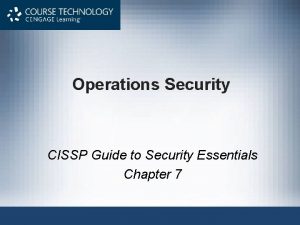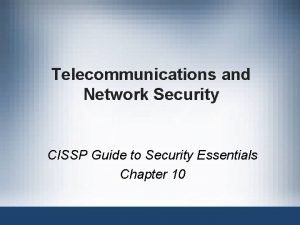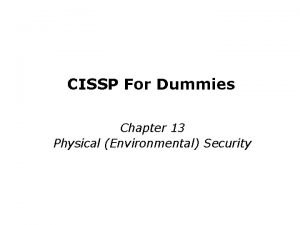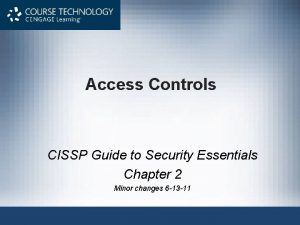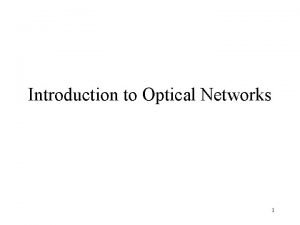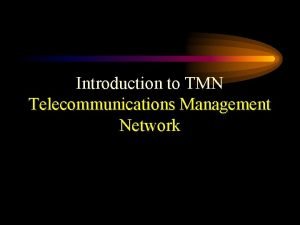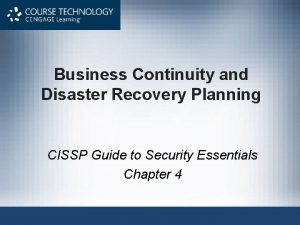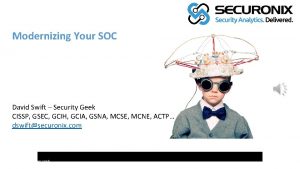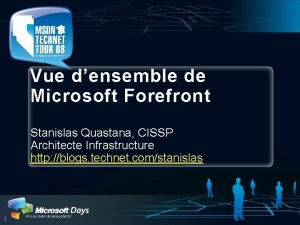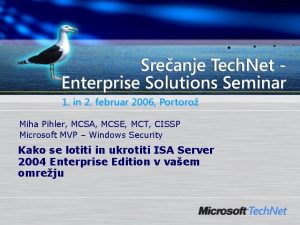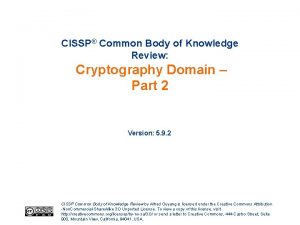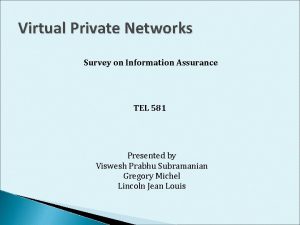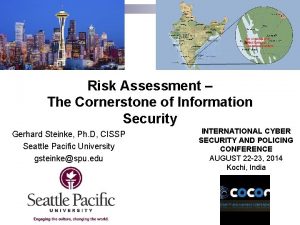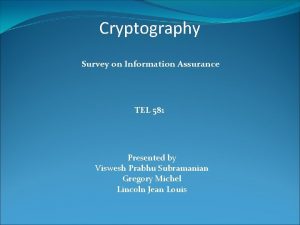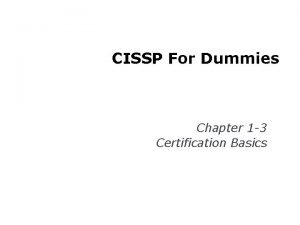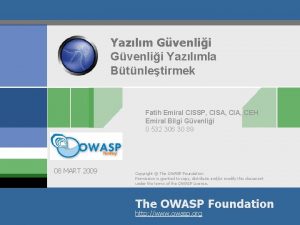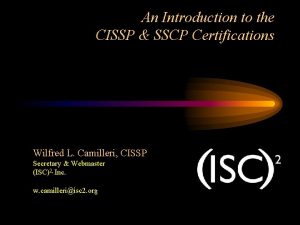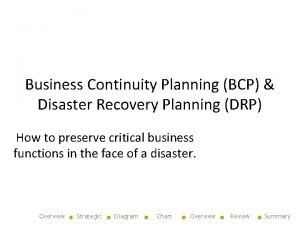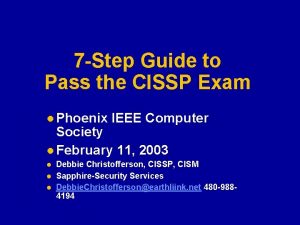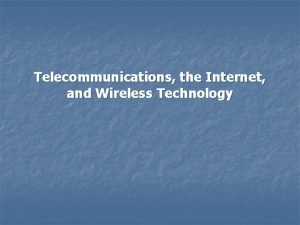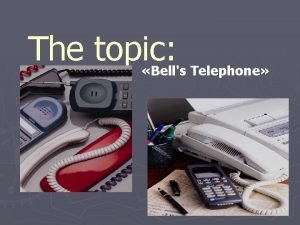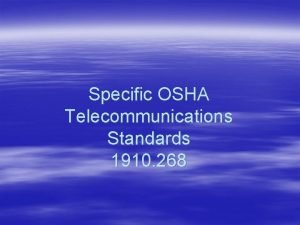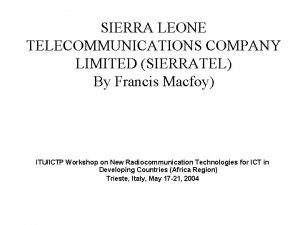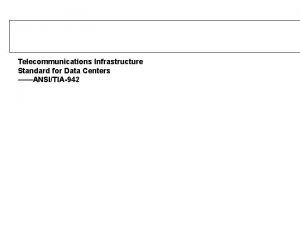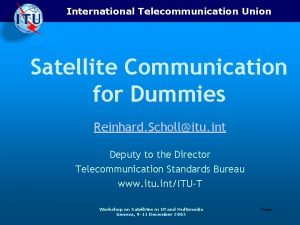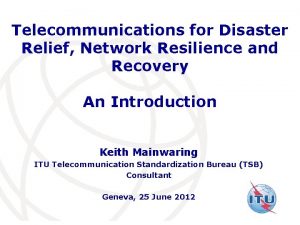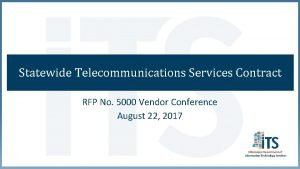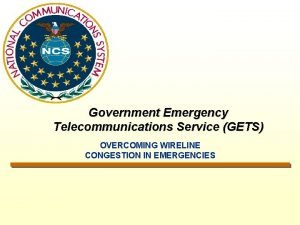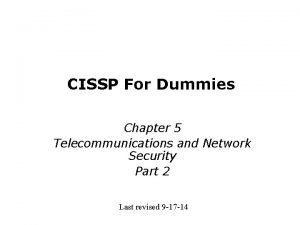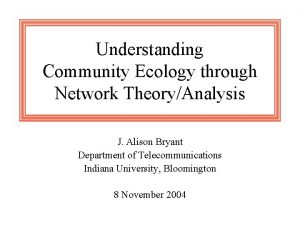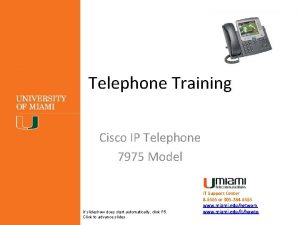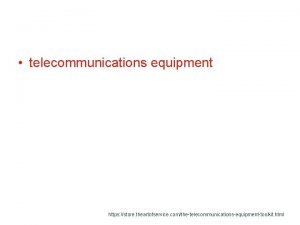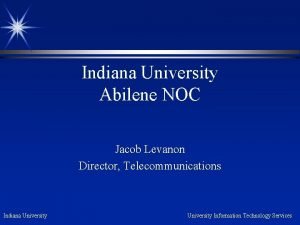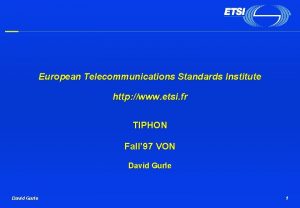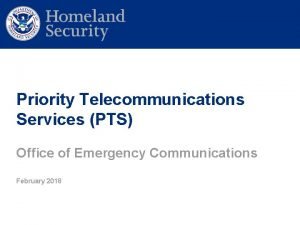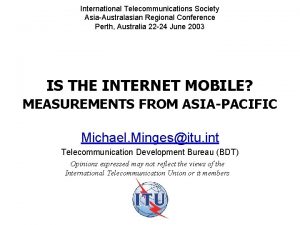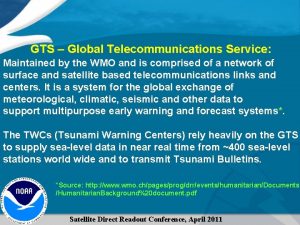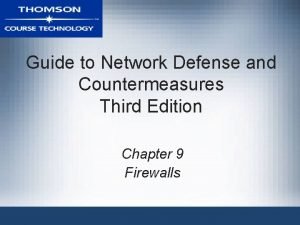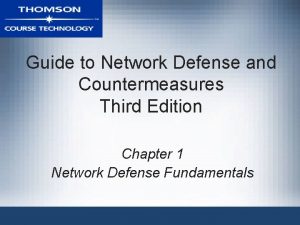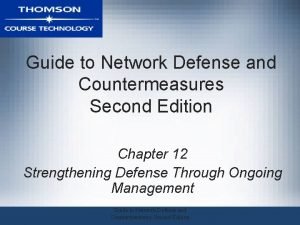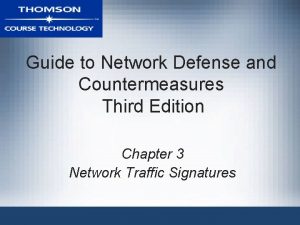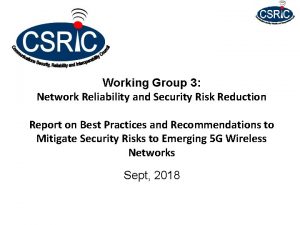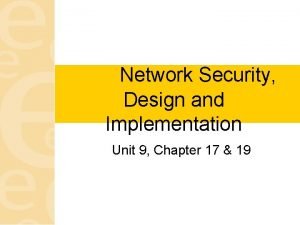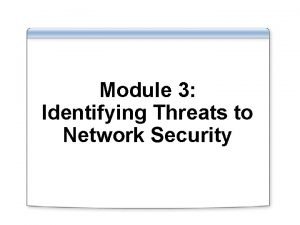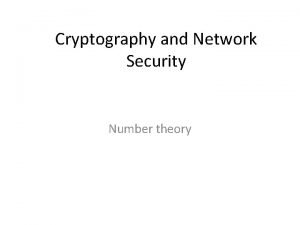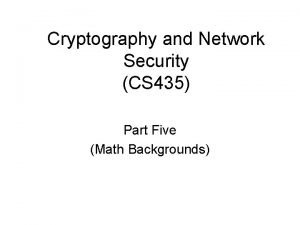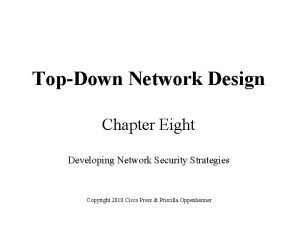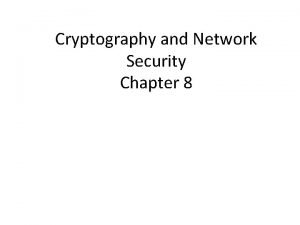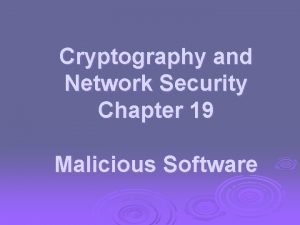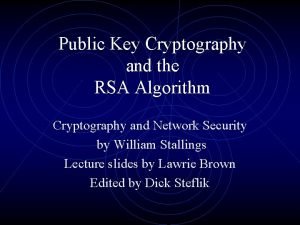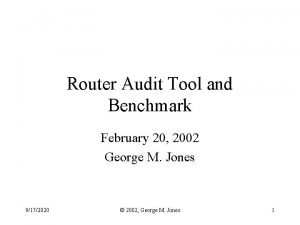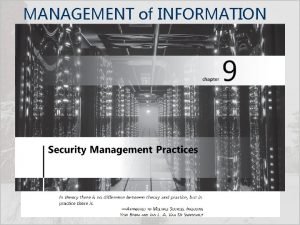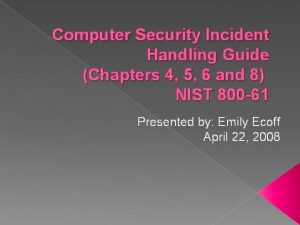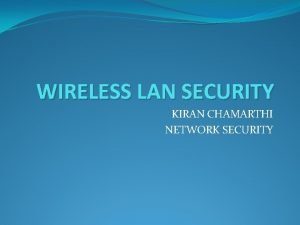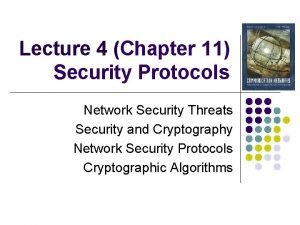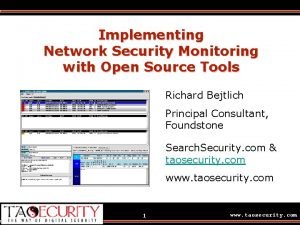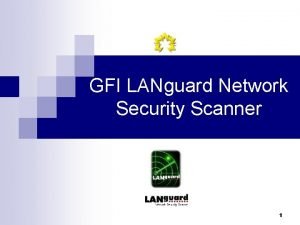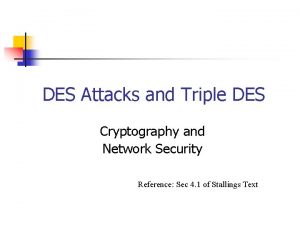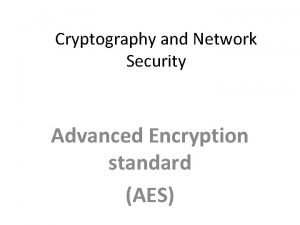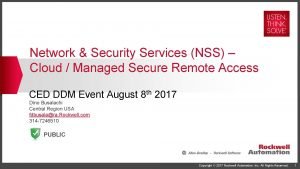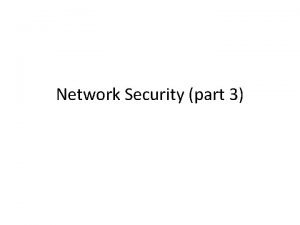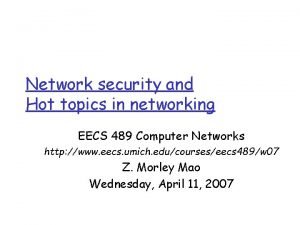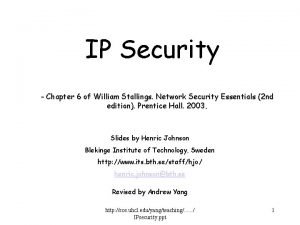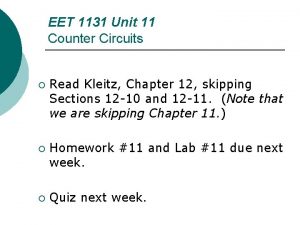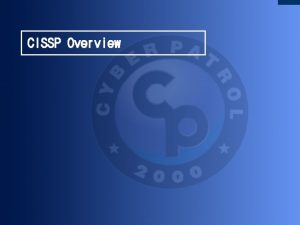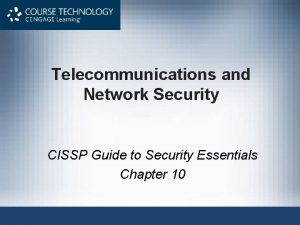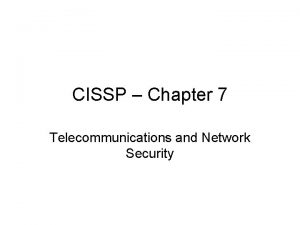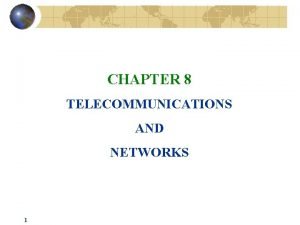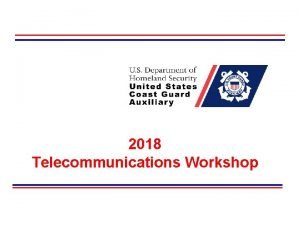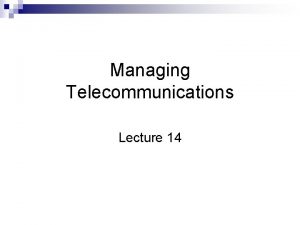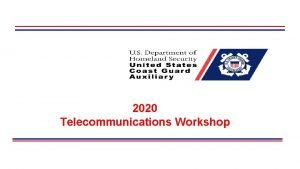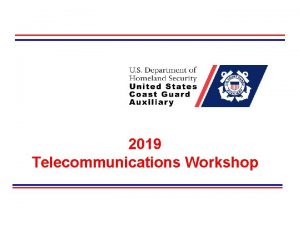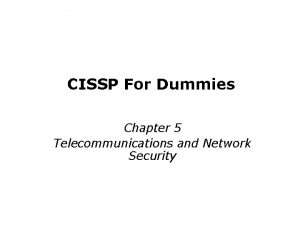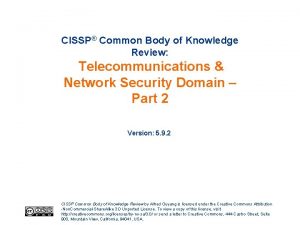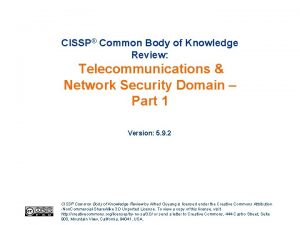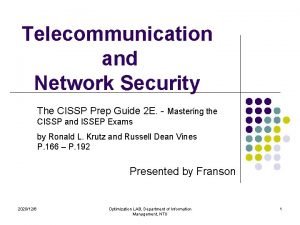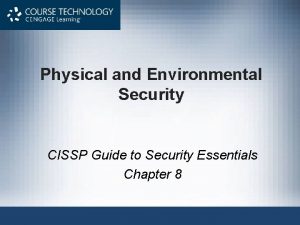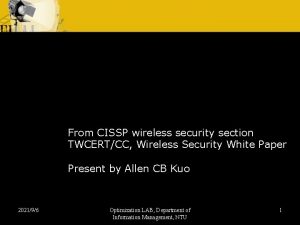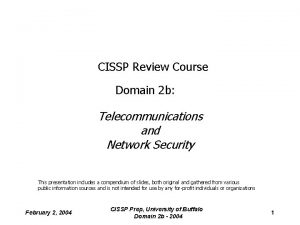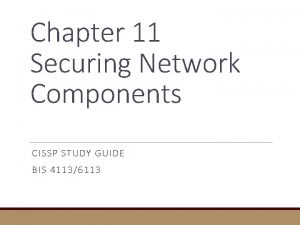Telecommunications and Network Security CISSP Guide to Security























































































































- Slides: 119

Telecommunications and Network Security CISSP Guide to Security Essentials Chapter 10

Objectives • Wireline and wireless telecommunication technologies • Wired and wireless network technologies • Network topologies and cabling • The OSI and TCP/IP network models CISSP Guide to Security Essentials 2

Objectives (cont. ) • TCP/IP networks, protocols, addressing, devices, routing, authentication, access control, tunneling, and services • Network based threats, attacks, vulnerabilities, and countermeasures CISSP Guide to Security Essentials 3

Wired Telecom Technologies • DS-1, aka T-1 – 24 voice or data channels, each 1. 544 Mbit/sec • Other T-carrier protocols – DS-3 (673 voice channels, 45 m. Bit/s) – DS-4 (4, 032 channels, 274 m. Bit/s) – DS-5 (5, 760 channels, 400 m. Bit/s) CISSP Guide to Security Essentials 4

Wired Telecom Technologies (cont. ) • E-1 – Euro version – 32 channels instead of 24, otherwise similar • SONET (Synchronous Optical NETwork) – High speed, fiber optic, encapsulates T-protocols, ATM, TCP/IP – OC-1 - 48. 960 Mbit/sec CISSP Guide to Security Essentials 5

Wired Telecom Technologies (cont. ) • SONET (cont. ) – OC-3 - 150. 336 Mbit/sec – OC-12 - 601. 344 Mbit/sec – OC-24 - 1, 202. 688 Mbit/sec CISSP Guide to Security Essentials 6

Wired Telecom Technologies (cont. ) • SONET (cont. ) – OC-48 - 2, 405. 376 Mbit/sec – OC-96 - 4, 810. 752 Mbit/sec – OC-192 - 9, 621. 504 Mbit/sec CISSP Guide to Security Essentials 7

Wired Telecom Technologies (cont. ) • Frame Relay – Link layer protocol * – Early packet-switched technology that used to transmit data between locations at a lower cost than dedicated DS-1 circuits – Switched Virtual Circuits (SVCs) and Permanent Virtual Circuits (PVCs) emulate dedicated T-1 * - discussed later in this chapter CISSP Guide to Security Essentials 8

Wired Telecom Technologies (cont. ) • ATM (Asynchronous Transfer Mode) – Synchronous, connection-oriented packet protocol – Packets called cells, are fixed length (5 byte header, 48 byte payload) CISSP Guide to Security Essentials 9

Wired Telecom Technologies (cont. ) • ATM (cont. ) – Intended to replace 10 m. B Ethernet, but it didn’t really catch on. 100 m. B and 1000 m. B Ethernet was favored instead, also giving way to MPLS. CISSP Guide to Security Essentials 10

Wired Telecom Technologies (cont. ) • DSL (Digital Subscriber Line) – Digital packet over copper voice circuits at higher clock rate, coexists with low frequency voice CISSP Guide to Security Essentials 11

Wired Telecom Technologies (cont. ) • DSL (cont. ) – Modem used on subscriber side to convert DSL signals to Ethernet (and sometimes Wi-Fi) – DSLAM (Digital Subscriber Line Access Multiplexer) on telco end aggregates signals CISSP Guide to Security Essentials 12

Wired Telecom Technologies (cont. ) • MPLS (Multiprotocol Label Switching) – Packet switched technology, encapsulates TCP/IP, ATM, SONET, Ethernet frames) – Carries voice + data, has Qo. S (quality of service) capabilities to guarantee jitter-free voice and other media such as video – Replacing Frame Relay and ATM CISSP Guide to Security Essentials 13

Wired Telecom Technologies (cont. ) • Other wired telecom technologies – Data Over Cable Service Interface Specification (DOCSIS) – PSTN (Public Switched Telephone Network) – ISDN (Integrated Services Digital Network) – SDH (Synchronous Digital Hierarchy) – X. 25 CISSP Guide to Security Essentials 14

Wireless Telecom Technologies • CDMA 2000 (code division multiple access) – Data transport: 1 XRTT (153 kbit/s), EVDO (2. 4 Mbit/s), EVDV (3. 1 Mbit/s) • GPRS (General Packet Radio Service) – Encapsulated in GSM (Global System for Mobile communications) protocol (114 kbit/s) CISSP Guide to Security Essentials 15

Wireless Telecom Technologies (cont. ) • EDGE (Enhanced Data rates for GSM Evolution) – Up to 1 Mbit/s • UMTS (Universal Mobile Telecommunications System) – Transported over WCDMA, up to 14 Mbit/s) CISSP Guide to Security Essentials 16

Wireless Telecom Technologies (cont. ) • Wi. MAX (Worldwide Interoperability for Microwave Access) – Based on IEEE 802. 16, Wi. MAX is a wireless competitor to DSL and cable modems, also competes with CDMA, GPRS, EDGE, UMTS CISSP Guide to Security Essentials 17

Wireless Telecom Technologies (cont. ) • Wi. MAX (cont. ) – Rates range from 2 to 12 Mbit/s, theoretically as high as 70 Mbit/s • CDPD (Cellular Digital Packet Data) – first data over cellular, used AMPS analog carrier, up to 19. 2 kbit/s CISSP Guide to Security Essentials 18

Wired Network Technologies • Ethernet – Frame-based protocol • • 14 byte header Payload (46 -1500 bytes) Checksum Inter-frame gap CISSP Guide to Security Essentials 19

Wired Network Technologies (cont. ) • Ethernet (cont. ) – Error detection: Carrier Sense Multiple Access with Collision Detection (CSMA/CD) – MAC address: 6 bytes. Format xx. xx. yy. yy. • xx. xx assigned to manufacturer CISSP Guide to Security Essentials 20

Wired Network Technologies (cont. ) • Ethernet devices – Hub – connects local stations together; broadcast – Repeater – extend signal over distances – Switch – like a hub but does not broadcast CISSP Guide to Security Essentials 21

Wired Network Technologies (cont. ) • Ethernet devices (cont. ) – Router – connect networks to each other – Gateway – translates various types of communications CISSP Guide to Security Essentials 22

Wired Network Technologies (cont. ) • Token ring – Logical ring – Speed: 4 Mbit/s and 16 Mbit/s – Mostly replaced by Ethernet CISSP Guide to Security Essentials 23

Wired Network Technologies (cont. ) • Universal Serial Bus (USB) – Successor to RS-232 serial – Speeds • USB 1. 0/1. 1 – 1. 5 Mbits/s and 12 Mbits/s • USB 2. 0 – 480 Mbits/s • USB 3. 0 – 4. 8 Gbits/s CISSP Guide to Security Essentials 24

Wired Network Technologies (cont. ) • Universal Serial Bus (cont. ) – Hot pluggable – Used to connect peripheral and human interface devices CISSP Guide to Security Essentials 25

Wired Network Technologies (cont. ) • RS-232 – Serial communications, speeds 110 bit/s – 57. 7 kbit/s – Used to connect communications devices such as modems, and human interface devices such as mice – Largely replaced by USB CISSP Guide to Security Essentials 26

Wired Network Technologies (cont. ) • HSSI (High Speed Serial Interface) – 52 Mbits/s, cable length 50’, used to connect WAN devices • Fibre Channel – Gigabit protocol used in SANs (Storage Area Networks) CISSP Guide to Security Essentials 27

Wired Network Technologies (cont. ) • FDDI (Fiber Distributed Data Interface) – Token technology over fiber that has been replaced by gigabit Ethernet and SONET CISSP Guide to Security Essentials 28

Wired Network Technologies (cont. ) • Network cabling – Ethernet • 10 BASE-T – this is the commonly twisted-pair network cable that supports the Category 3, 5, or 6 ANSI standard. This cable… CISSP Guide to Security Essentials 29

Wired Network Technologies (cont. ) • 10 BASE-T (cont. ) …has 8 conductors, of which 4 are used. An 8 -pin RJ 45 connector is used to connect a cable to a device. CISSP Guide to Security Essentials 30

Wired Network Technologies (cont. ) – Ethernet (cont. ) • 100 BASE-TX – the same twisted-pair network cable (Category 5 and 6) and connectors as 10 BASE-T, and also uses just 4 of the 8 conductors CISSP Guide to Security Essentials 31

Wired Network Technologies (cont. ) – Ethernet (cont. ) • 1000 BASE-T – the same twisted-pair network cable and connectors as 100 BASE-TX, except that all 8 conductors are used. CISSP Guide to Security Essentials 32

Wired Network Technologies (cont. ) – Ethernet (cont. ) • 10 BASE 2 – the old “thinnet” coaxial cabling with twist-lock BNC connectors – rarely used. • 10 BASE 5 – the old “thicknet” coaxial cabling that is rarely used. CISSP Guide to Security Essentials 33

Wired Network Technologies (cont. ) • Twisted pair cabling – Category 3 – consists of four twisted pairs in a single jacket. Suitable only for 10 Mbit/s Ethernet. Superseded by Category 5 and 5 e. CISSP Guide to Security Essentials 34

Wired Network Technologies (cont. ) • Twisted pair cabling (cont. ) – Category 5 – consists of four twisted pairs in a single jacket. Maximum length is 100 m. Suitable for 100 Mbit/s and can be used for Gigabit Ethernet. CISSP Guide to Security Essentials 35

Wired Network Technologies (cont. ) • Twisted pair cabling (cont. ) – Category 5 e – supersedes Category 5 and includes specifications for far end crosstalk. – Category 6 – backward compatible with Category 5 and 5 e, but higher specifications for noise and crosstalk, making it more suitable for Gigabit Ethernet. CISSP Guide to Security Essentials 36

Wired Network Technologies (cont. ) • Twisted pair cabling (cont. ) – Category 7 – even more stringent than Category 6 cabling, Cat-7 is suitable for 10 Gbit/s networks. CISSP Guide to Security Essentials 37

Wired Network Technologies (cont. ) • Cabling – Optical • Carries signal in the form of light instead of electricity • Greater speeds and distances possible • More expensive CISSP Guide to Security Essentials 38

Network Topologies • Bus. All of the nodes in the network are connected to a single conductor. A break in the network conductor will cause some or the entire network to stop functioning. Early Ethernet networks consisting of thinnet coaxial cabling were bus networks. CISSP Guide to Security Essentials 39

Network Topologies (cont. ) • Ring. All of the nodes are connected to exactly two other nodes, forming a circular loop. Breaking any conductor will cause the network to stop functioning. • Star. All nodes are connected to a central device. A break in a conductor… CISSP Guide to Security Essentials 40

Network Topologies (cont. ) • Star. (cont. ) …will disconnect only one node, and the remaining nodes will continue functioning. Ethernet networks are physical stars, with computers connected to central hubs or switches. Token ring networks, while logically as a ring, are physically wired as a star. CISSP Guide to Security Essentials 41

Wireless Network Technologies • Wi-Fi, also known as WLAN, Wireless LAN – Wireless data link layer network protocol – Bandwidth up to 54 Mbit/s, distances to 100 m CISSP Guide to Security Essentials 42

Wireless Network Technologies (cont. ) • Wi-Fi standards Standard 802. 11 a 802. 11 b 802. 11 g Spectrum 5 GHz 2. 4 GHz Data Rate 54 Mbit/s 11 Mbit/s 54 Mbit/s 802. 11 n 802. 11 y 2. 4/5 GHz 3. 7 GHz 248 Mbit/s 250 m 2009 54 Mbit/s 5000 m 2008 CISSP Guide to Security Essentials Range 120 m 140 m Released 1999 2003 43

Wireless Network Technologies (cont. ) • Wi-Fi security – SSID should be a non-default value – SSID broadcast should be disabled – MAC access control CISSP Guide to Security Essentials 44

Wireless Network Technologies (cont. ) • Wi-Fi security (cont. ) – Authentication – Encryption • WEP (Wired Equivalent Privacy) • WPA (Wireless Protected Access) • WPA 2 (superset of WPA, full standard) CISSP Guide to Security Essentials 45

Wireless Network Technologies (cont. ) • Bluetooth – Personal Area Network (PAN) technology – Data rate: 1 Mbit/s – 3 Mbit/s – Distance: up to 10 m CISSP Guide to Security Essentials 46

Wireless Network Technologies (cont. ) • Bluetooth (cont. ) – Devices can authenticate through a process called “pairing”, during which two devices can exchange a cryptographic secret key that the two devices can later use CISSP Guide to Security Essentials 47

Wireless Network Technologies (cont. ) • Bluetooth (cont. ) – Communications between paired devices can also be encrypted CISSP Guide to Security Essentials 48

Wireless Network Technologies (cont. ) • Ir. DA – Infrared Data Association standard – Infrared light spectrum from 2. 4 kbit/s to 16 Mbit/s • Requires line-of-sight – Once popular, now being replaced with Bluetooth CISSP Guide to Security Essentials 49

Wireless Network Technologies (cont. ) • Wireless USB (WUSB) – Wireless protocol designed for wireless connectivity of various computer peripherals • Printers, digital cameras, hard disks, and other high-throughput devices. CISSP Guide to Security Essentials 50

Wireless Network Technologies (cont. ) • Wireless USB (cont. ) – Bandwidth ranges from 110 Mbit/s at 10 meters to 480 Mbit/s at 3 meters – 3. 1 to 10. 6 GHz frequency range CISSP Guide to Security Essentials 51

Wireless Network Technologies (cont. ) • Near Field Communication (NFC) – Ultra-short distance (up to 10 cm or 4”) – Rates: 106 kbit/s, 212 kbit/s, or 424 kbit/s – Active or passive mode • Passive mode ideal for key card access control CISSP Guide to Security Essentials 52

OSI Protocol Model • • Physical Data link Network Transport Session Presentation Application CISSP Guide to Security Essentials 53

OSI Protocol Model: Physical • Concerned with a network’s physical media – Electrical – Optical – Radio frequency CISSP Guide to Security Essentials 54

OSI Protocol Model: Physical (cont. ) • Example standards – RS-232, RS-422, T 1, E 1, 10 Base-T, SONET, DSL, 802. 11 a (physical), Twinax CISSP Guide to Security Essentials 55

OSI Protocol Model: Data Link • Concerned with the transfer of data between nodes • Manages error correction for any errors that take place at the physical layer CISSP Guide to Security Essentials 56

OSI Protocol Model: Data Link (cont. ) • Example standards – 802. 3 (Ethernet), 802. 11 a MAC, GPRS, Apple. Talk, ATM, FDDI, Fibre Channel, Frame Relay, PPP, SLIP, Token Ring, Wi-MAX CISSP Guide to Security Essentials 57

OSI Protocol Model: Network • Used to transport variable-length data sequences between nodes • Manages fragmentation and reassembly • Communications are point-to-point CISSP Guide to Security Essentials 58

OSI Protocol Model: Network (cont. ) • No notion of a “connection” • Delivery of data not done here • Example standards – IP, ICMP, ARP, IPX CISSP Guide to Security Essentials 59

OSI Protocol Model: Transport • Manages the delivery of data from node to node on a network – Even when there are intermediate devices such as routers and a variety of physical media between the nodes CISSP Guide to Security Essentials 60

OSI Protocol Model: Transport (cont. ) • Manages the delivery of data from node to node on a network (cont. ) – Manages “connections” • Guarantee the order of delivery of data packets, packet reassembly, error recovery – Examples: UDP, TCP, IPsec, PPTP, L 2 TP, SPX CISSP Guide to Security Essentials 61

OSI Protocol Model: Session • Manages connections between nodes, including session establishment, communication, and teardown • Example standards – Net. BIOS, TCP, SIP CISSP Guide to Security Essentials 62

OSI Protocol Model: Presentation • Deals with the presentation or representation of data in a communications session – Character set translation – Compression – Encryption CISSP Guide to Security Essentials 63

OSI Protocol Model: Presentation (cont. ) • Examples of presentation - layer standards include SSL, TLS, MIME, and MPEG CISSP Guide to Security Essentials 64

OSI Protocol Model: Application • Top-most layer in the OSI network model • Concerned with the delivery of data to and from applications • Examples standards – DNS, NFS, NTP, DHCP, SMTP, HTTP, SNMP, SSH, Telnet, WHOIS CISSP Guide to Security Essentials 65

TCP/IP Protocol Model • • • Physical Data link Network / internet Transport Application CISSP Guide to Security Essentials 66

TCP/IP Protocol Model: Physical • Physical medium used to carry traffic – – Twisted pair cable Coaxial cable Optical fiber SONET CISSP Guide to Security Essentials 67

TCP/IP Protocol Model: Physical (cont. ) • Physical medium (cont. ) – – T-1 and E-1 telecommunications links DSL ISDN Wi-Fi CISSP Guide to Security Essentials 68

TCP/IP Protocol Model: Physical (cont. ) • Physical medium (cont. ) – – Bluetooth USB GPRS CDMA CISSP Guide to Security Essentials 69

TCP/IP Protocol Model: Data Link • Concerned with node to node delivery • Example standards – Wi-Fi – Ethernet – Token Ring CISSP Guide to Security Essentials 70

TCP/IP Protocol Model: Data Link (cont. ) • Example standards (cont. ) – ATM – Frame Relay – PPP CISSP Guide to Security Essentials 71

TCP/IP Protocol Model: Network • Also known as the Internet layer • Concerned with end-to-end packet delivery, even through intermediate devices such as switches and routers CISSP Guide to Security Essentials 72

TCP/IP Protocol Model: Network (cont. ) • Protocols – – IPv 4 IPv 6 ARP RARP CISSP Guide to Security Essentials 73

TCP/IP Protocol Model: Network (cont. ) • Protocols (cont. ) – ICMP – IGMP – IPsec CISSP Guide to Security Essentials 74

TCP/IP Protocol Model: Network (cont. ) • Network layer routing protocols – – RIP OSPF IS-IS BGP CISSP Guide to Security Essentials 75

TCP/IP Protocol Model: Network (cont. ) • Network layer addressing – Network addresses in IPv 4 are 32 bits in length • Expressed as a dot-decimal notation, xx. xx. xx, where the range of each ‘xx’ is 0 -255 decimal. • Typical network address is 141. 204. 13. 200 CISSP Guide to Security Essentials 76

TCP/IP Protocol Model: Network (cont. ) • Network layer addressing (cont. ) – Subnets and subnet masking • IP address divided into two parts: network and node • Subnet mask used to distinguish network and node portions; e. g. 255. 0 CISSP Guide to Security Essentials 77

TCP/IP Protocol Model: Network (cont. ) • Network layer addressing (cont. ) – Default gateway – node that connects to other networks – Address allocation by Regional Internet Registry (RIR), ISPs CISSP Guide to Security Essentials 78

TCP/IP Protocol Model: Network (cont. ) • Network layer addressing (cont. ) – Reserved address blocks • Private networks – 10. 0 – 10. 255 – 172. 16. 0. 0 - 172. 31. 255 – 192. 168. 0. 0 - 192. 168. 255 CISSP Guide to Security Essentials 79

TCP/IP Protocol Model: Network (cont. ) • Network layer addressing (cont. ) – Reserved address blocks (cont. ) • Loopback: 127. 0. 0. 1 - 127. 0. 0. 255 (127. 0. 0. 1 = “me”) • Multicast: 224. 0. 0. 0 -239. 255 CISSP Guide to Security Essentials 80

TCP/IP Protocol Model: Network (cont. ) • Network layer addressing (cont. ) – Network address translation (NAT) • Internal private addresses are translated into public routable addresses at the network boundary CISSP Guide to Security Essentials 81

TCP/IP Protocol Model: Network (cont. ) • Network layer addressing (cont. ) – Classful networks • Class A • Class B • Class C CISSP Guide to Security Essentials 82

TCP/IP Protocol Model: Network (cont. ) • Network layer addressing (cont. ) – Classless networks (Classless Internet Domain Routing (CIDR) • Variable length subnet masks, not limited to just Class A, B, C CISSP Guide to Security Essentials 83

TCP/IP Protocol Model: Network (cont. ) • Network layer addressing (cont. ) – Types of addressing • Unicast (regular node addresses) • Broadcast (send to all nodes on a subnet) CISSP Guide to Security Essentials 84

TCP/IP Protocol Model: Network (cont. ) – Types of addressing (cont. ) • Multicast (send to a group of notes on different networks) • Anycast (send to only one of a group of nodes) CISSP Guide to Security Essentials 85

TCP/IP Protocol Model: Transport • TCP Protocol – Connection oriented, persistent connections, dedicated and ephemeral ports, sequencing, guaranteed delivery – Examples: FTP, HTTP, Telnet CISSP Guide to Security Essentials 86

TCP/IP Protocol Model: Transport (cont. ) • UDP Protocol – Connectionless, dedicated port numbers only, no sequencing, no guarantee of delivery – Examples: DNS, TFTP, Vo. IP CISSP Guide to Security Essentials 87

TCP/IP Protocol Model: Application • Topmost layer in the TCP/IP protocol stack • Protocols: DHCP, DNS, Finger, FTP, HTTP, LDAP, NFS, NIS, NTP, Rlogin, RPC, Rsh, SIP, SMTP, SNMP, Telnet, TFTP, Vo. IP, Whois CISSP Guide to Security Essentials 88

TCP/IP Routing Protocols • Router-to-router communication protocol used by routers to help determine the most efficient network routes between two nodes on a network • Helps routers make good routing decisions (making the right choice about which way to forward packets) CISSP Guide to Security Essentials 89

TCP/IP Routing Protocols (cont. ) • RIP (Routing Information Protocol) – one of the early routing protocols – Hop count the primary metric, maximum = 15 • IGRP (Interior Gateway Routing Protocol) – Cisco proprietary – Multiple metrics: hop count (max 255), bandwidth, delay, load, MTU, and reliability CISSP Guide to Security Essentials 90

TCP/IP Routing Protocols (cont. ) • EIGRP (Enhanced Interior Gateway Routing Protocol) – Cisco proprietary – Advances over IGRP including VLSM • OSPF (Open Shortest Path First) – Open standard for enterprise networks – Metric is “path cost” (primarily hops and speed) – Uses authentication to prevent route spoofing CISSP Guide to Security Essentials 91

TCP/IP Routing Protocols (cont. ) • BGP (Border Gateway Protocol) – the dominant Internet routing algorithm • IS-IS (Intermediate system to intermediate system) – used primarily by large ISP networks CISSP Guide to Security Essentials 92

Remote Access / Tunneling Protocols • Tunneling: encapsulating packets of one protocol within another – can include encryption – Reasons: protection of encapsulated protocol; hide details of intermediary network, authentication of traffic CISSP Guide to Security Essentials 93

Remote Access / Tunneling Protocols (cont. ) • Tunneling: (cont. ) – Protocols • VPN – generic term for tunneled (and usually encrypted) network connection from a public network to a private network CISSP Guide to Security Essentials 94

Remote Access / Tunneling Protocols (cont. ) – Protocols (cont. ) • • SSL / TLS SSH IPsec Others: L 2 TP, PPTP, SLIP CISSP Guide to Security Essentials 95

Authentication Protocols • RADIUS (Remote Authentication Dial In User Service) – Over-the-wire protocol from client to AAA (authentication, authorization, accounting) server • Diameter – more advanced RADIUS replacement CISSP Guide to Security Essentials 96

Authentication Protocols (cont. ) • TACACS (Terminal Access Controller Access. Control System) – authenticates user to a network. – Between access point or gateway and an AAA server • 802. 1 X – port level access control. System authenticates before user. CISSP Guide to Security Essentials 97

Authentication Protocols (cont. ) • CHAP (Challenge-Handshake Authentication Protocol) – Between client system and gateway • PPP uses CHAP CISSP Guide to Security Essentials 98

Authentication Protocols (cont. ) • EAP (Extensible Authentication Protocol) – Authentication Framework – used to authenticate users in wired and wireless networks. Used by WPA and WPA 2 wireless network standards. CISSP Guide to Security Essentials 99

Authentication Protocols (cont. ) • PEAP (Protected Extensible Authentication Protocol) – used in wireless networks to authenticate users – PEAP uses an SSL/TLS tunnel to encrypt authentication information • PAP (Password Authentication Protocol) – unsecure because protocol is unencrypted CISSP Guide to Security Essentials 100

Network Threats • The expressed potential for the occurrence of a harmful event such as an attack – Do. S / DDo. S – designed to flood or cause malfunction – Teardrop - attacker sends mangled packet fragments with overlapping and oversized payloads to a target system CISSP Guide to Security Essentials 101

Network Threats (cont. ) • Threats (cont. ) – Sequence number – guesses upcoming sequence numbers as a method for disrupting communications – Smurf - large number of forged ICMP echo requests. The packets are sent to a target network’s broadcast address, which causes all systems on the network to respond CISSP Guide to Security Essentials 102

Network Threats (cont. ) • Threats (cont. ) – Ping of Death – ICMP echo request, 64 k length – SYN flood – large volume of TCP SYN packets, consumes resources on target system – Worm – automated, self-replicating program CISSP Guide to Security Essentials 103

Network Threats (cont. ) • Threats (cont. ) – Spam – unsolicited commercial e-mail (UCE): fraud, malware, marketing – Phishing – emails luring users to fraudulent sites – Pharming – attack on DNS that redirects access to legitimate sites to imposter sites CISSP Guide to Security Essentials 104

Network Vulnerabilities • • Unnecessary open ports Unpatched systems Poor and outdated configurations Exposed cabling CISSP Guide to Security Essentials 105

Network Countermeasures • Access control lists • Firewalls • Intrusion Detection System (IDS) – Network based (NIDS) – Host based (HIDS) CISSP Guide to Security Essentials 106

Network Countermeasures (cont. ) • Intrusion Prevention System (IPS) – Network and host based • Protection of network cabling • Anti-virus software • Private addressing (10. *. *. *, etc. ) CISSP Guide to Security Essentials 107

Network Countermeasures (cont. ) • • Close unnecessary ports and services Security patches Unified Threat Management (UTM) Gateways – filtering intermediaries CISSP Guide to Security Essentials 108

Summary • Wired telecom technologies include DS-1 (T-1), SONET, Frame Relay, ATM, DSL, and MPLS • Wireless telecom technologies include CDMA 2000 (which includes 1 x. RTT and EVDO), GPRS, EDGE, UMTS, and Wi. MAX CISSP Guide to Security Essentials 109

Summary (cont. ) • Wired network technologies include Ethernet, ATM, Token Ring, USB, RS-232 • Wireless network technologies include Wi -Fi and Ir. DA CISSP Guide to Security Essentials 110

Summary (cont. ) • Ethernet is a frame technology that uses an 8 -octet address • The three network topologies are bus, ring, and star CISSP Guide to Security Essentials 111

Summary (cont. ) • Wi-Fi wireless networks can be secured by turning off SSID broadcast, using a non-default SSID, utilizing WPA or WPA 2 encryption, using user based authentication, and MAC based access control CISSP Guide to Security Essentials 112

Summary (cont. ) • The seven layers of OSI are: physical, data link, network, transport, session, presentation, and application • The five-layer of TCP/IP are: physical, data link, network / internet, transport, and application CISSP Guide to Security Essentials 113

Summary (cont. ) • Common tunneling (encapsulation) protocols are SSL, SSH, IPsec, L 2 TP, PPTP, and PPP • Common authentication protocols are RADIUS, Diameter, CHAP, EAP, and PEAP. TACACS and PAP are no longer widely used. CISSP Guide to Security Essentials 114

Summary (cont. ) • TCP/IP data link layer protocols are Ethernet, Token Ring, ATM, Frame Relay, and PPP • TCP/IP network layer protocols are IPv 4, IPv 6, ARP, RARP, ICMP, IGMP, and IPsec CISSP Guide to Security Essentials 115

Summary (cont. ) • TCP/IP transport layer protocols are TCP and UDP • TCP/IP application layer protocols are DHCP, DNS, FTP, HTTP, LDAP, NTP, RPC, SIP, SMTP, SNMP, TELNET, TFTP, and Vo. IP CISSP Guide to Security Essentials 116

Summary (cont. ) • Common network based attacks are Denial of Service (Do. S), Distributed Denial of Service (DDo. S), Teardrop, Sequence number, Smurf, Ping of Death, SYN flood, worms, spam, and phishing. CISSP Guide to Security Essentials 117

Summary (cont. ) • Common network based vulnerabilities are unneeded open ports, unpatched systems and devices, and misconfigured systems and devices. • Effective countermeasures are access control lists (ACLs), firewalls, intrusion… CISSP Guide to Security Essentials 118

Summary (cont. ) • …detection systems, intrusion prevention systems, private addressing, closing unnecessary ports and services, installing security patches, and using gateways. UTM devices that perform many defensive functions are gaining use. CISSP Guide to Security Essentials 119
 Cissp guide to security essentials
Cissp guide to security essentials Cissp guide to security essentials
Cissp guide to security essentials Guide to network security
Guide to network security Security guide to network security fundamentals
Security guide to network security fundamentals Security guide to network security fundamentals
Security guide to network security fundamentals Cissp physical security
Cissp physical security Corrective controls examples
Corrective controls examples Telecommunications network architecture
Telecommunications network architecture Tmn system
Tmn system Wireless security in cryptography
Wireless security in cryptography Business continuity plan steps cissp
Business continuity plan steps cissp What is the osi security architecture
What is the osi security architecture Electronic mail security in network security
Electronic mail security in network security Provate security
Provate security Soc cissp
Soc cissp Bcp vs drp cissp
Bcp vs drp cissp Microsoft cissp
Microsoft cissp Mednaslov
Mednaslov Reference monitor cissp
Reference monitor cissp Cissp common body of knowledge
Cissp common body of knowledge Derek schatz
Derek schatz Cissp
Cissp Cissp quantitative risk analysis
Cissp quantitative risk analysis Cissp
Cissp Cissp basics
Cissp basics Cissp nedir
Cissp nedir Shon harris cissp
Shon harris cissp Cissp exam cost philippines
Cissp exam cost philippines Cissp or sscp
Cissp or sscp Windsor castle postcode
Windsor castle postcode Bcp vs drp cissp
Bcp vs drp cissp Boson cissp promo code
Boson cissp promo code Telecommunication and data communication
Telecommunication and data communication Electronics and telecommunications research institute
Electronics and telecommunications research institute Telecommunications, the internet, and wireless technology
Telecommunications, the internet, and wireless technology Telecommunications, the internet, and wireless technology
Telecommunications, the internet, and wireless technology Difference lan wan
Difference lan wan A pioneer in the field of telecommunications
A pioneer in the field of telecommunications Project management telecommunications
Project management telecommunications Osha telecommunications standards
Osha telecommunications standards Sierra leone telecommunications company
Sierra leone telecommunications company Telecommunications act of 1996
Telecommunications act of 1996 Venture capital telecommunications
Venture capital telecommunications Telecommunications infrastructure standard for data centers
Telecommunications infrastructure standard for data centers Telecommunications for dummies
Telecommunications for dummies Disaster recovery telecommunications
Disaster recovery telecommunications Rfp for telecommunications services
Rfp for telecommunications services Government emergency telecommunications service
Government emergency telecommunications service Telecommunications engineering
Telecommunications engineering Telecommunications for dummies
Telecommunications for dummies Department of telecommunications
Department of telecommunications Department of telecommunications
Department of telecommunications French telecommunications equipment company
French telecommunications equipment company Digital telecommunications
Digital telecommunications Iu telecommunications
Iu telecommunications European telecommunications standards institute
European telecommunications standards institute Digital telecommunications
Digital telecommunications Government emergency telecommunications service
Government emergency telecommunications service International telecommunications society
International telecommunications society Wireless telecommunications industry analysis
Wireless telecommunications industry analysis Gts telecommunications
Gts telecommunications Guide to network defense and countermeasures
Guide to network defense and countermeasures Guide to network defense and countermeasures
Guide to network defense and countermeasures Operational auditing
Operational auditing Whirshark
Whirshark Explain virtual circuit and datagram network
Explain virtual circuit and datagram network Features of peer to peer network and client server network
Features of peer to peer network and client server network Network centric computing
Network centric computing Information rules a strategic guide to the network economy
Information rules a strategic guide to the network economy 5g americas
5g americas Network security design and implementation
Network security design and implementation Module 3: information and network security
Module 3: information and network security Cryptography and network security 6th edition
Cryptography and network security 6th edition Introduction to network security and cryptography
Introduction to network security and cryptography Number theory in network security
Number theory in network security Firewall in cryptography and network security
Firewall in cryptography and network security Authentication in cryptography and network security
Authentication in cryptography and network security Intruders in cryptography and network security
Intruders in cryptography and network security Primitive root in cryptography and network security
Primitive root in cryptography and network security Cryptography and network security 6th edition pdf
Cryptography and network security 6th edition pdf Cryptography and network security 7th edition
Cryptography and network security 7th edition Euler's theorem in cryptography and network security
Euler's theorem in cryptography and network security Cryptography and network security 4th edition
Cryptography and network security 4th edition Euler's theorem in cryptography
Euler's theorem in cryptography Multiplicative inverse
Multiplicative inverse Digital signature in cryptography and network security
Digital signature in cryptography and network security Gcd(1970,1066)
Gcd(1970,1066) Pgp in cryptography and network security
Pgp in cryptography and network security Network design and security
Network design and security It network security greensboro
It network security greensboro Euler's theorem in cryptography and network security
Euler's theorem in cryptography and network security Malicious software in cryptography
Malicious software in cryptography Introduction to cryptography and network security
Introduction to cryptography and network security Computer and network security
Computer and network security Rsa algorithm in cryptography and network security
Rsa algorithm in cryptography and network security Introduction to cryptography and network security
Introduction to cryptography and network security Nsa router security configuration guide
Nsa router security configuration guide Nist sp 800-55
Nist sp 800-55 Computer security incident handling guide
Computer security incident handling guide Integrity in e commerce
Integrity in e commerce Topology in computer
Topology in computer Network systems design using network processors
Network systems design using network processors Distinguish between circuit switching and packet switching
Distinguish between circuit switching and packet switching Wlan network
Wlan network Palo alto networks certified network security consultant
Palo alto networks certified network security consultant Network security protocols
Network security protocols William stallings network security essentials 5th edition
William stallings network security essentials 5th edition What is message authentication code
What is message authentication code Playfair cipher
Playfair cipher Open source network security monitoring
Open source network security monitoring Languard network security scanner
Languard network security scanner Triple des meet in the middle attack
Triple des meet in the middle attack Aes in network security
Aes in network security Modern network security
Modern network security Nss network security services
Nss network security services Network security topologies
Network security topologies Interesting topics in network security
Interesting topics in network security Kr
Kr Ic chip 74190
Ic chip 74190 Ec-council network security administrator
Ec-council network security administrator
